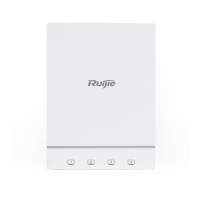Configuration Guide Configuring FAT APs
This standard operates both at 2.4 GHz and 5 GHz bands, and provides the highest data transmission rate of 600 Mbit/s.
Devices supporting 802.11n are backward-compatible with 802.11a/b/g.
MCS
The RF rate of 802.11n is configured through the index of Modulation and Coding Scheme (MCS). The MCS table is a
representation form in which 802.11n expresses the communication rate of a WLAN. MCS uses the factors that affect
communication rates as the columns and the MCS indexes as the rows to form a rate table. Therefore, each MCS index
corresponds to physical transmission rates under a group of parameters. For complete description about the MCS rate table,
see IEEE P802.11n D2.00.
Configuring the Range of Wireless Users Accessing an AP
An STA searches for APs by means of active scanning or passive scanning.
Active scanning: An STA sends a Probe Request frame to an AP for access. The AP verifies the validity of the request
and then sends a Probe Response frame.
Passive scanning: An AP regularly broadcasts beacon frames. The STA attempts to access the AP after monitoring the
beacon frames.
To control the network coverage of an AP and improve the transmission quality of wireless signals, you may limit STAs that
can access the AP. Firstly, control the range of beacon frames broadcasted by the AP to reduce access of remote STAs.
Secondly, control the minimum value of RSSI when STAs access the AP. If the RSSI of a request frame received from an
STA is smaller than the minimum value, the STA cannot access the AP. Thirdly, control the minimum value of RSSI when
STA data is transmitted. When the RSSI of a data frame received from an STA is smaller than this value, the STA is kicked
off so that the STA can access an AP with better wireless signals.
Configuring STA Aging
When an STA accesses a WLAN, the system automatically sets the aging time for the STA. If no information is received from
this STA within the aging time, it is assumed that the STA has left the WLAN and the system deletes the STA from the
network.
Configuring Wireless Channels
A wireless channel is a medium channel for transmitting RF signals between an AP and STA. Different countries and bands
support different channels. In China, the 2.4 GHz band can be configured with 13 channels (channels 1, 2, 3…and 13); the 5
GHz band can be configured with 24 channels (channels 36, 40, 44, 48, 52, 56, 60, 64, 100, 104, 108, 112, 116, 120, 124,
128, 132, 136, 140, 149, 153, 157, 161 and 165). At the 2.4 GHz band, overlapped channels may cause interference for
each other. To avoid conflict of wireless signals, it is recommended that non-overlapped channels (such as channels 1, 6,
and 11) be configured. At the 5 GHz band, the 24 channels are not overlapped and do not cause interference for each other.
Configuring Packet Fragmentation
To improve the success ratio of transmission, the IEEE 802.11 MAC protocol allows to fragment packets for transmission.
Fragmenting packets according to fragmentation thresholds can reduce the chance of interference and reduce bandwidth
waste even upon re-transmission.

